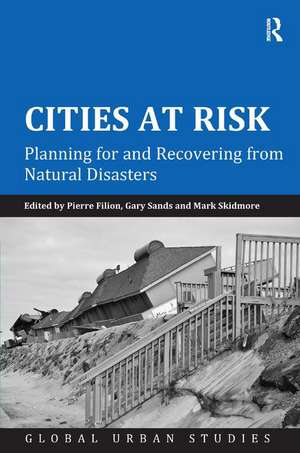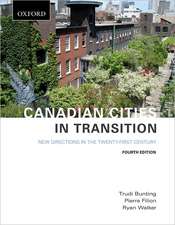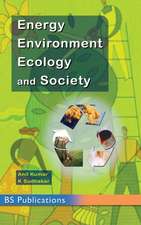Cities at Risk: Planning for and Recovering from Natural Disasters: Global Urban Studies
Autor Pierre Filion, Gary Sandsen Limba Engleză Hardback – 28 oct 2015
| Toate formatele și edițiile | Preț | Express |
|---|---|---|
| Paperback (1) | 436.14 lei 6-8 săpt. | |
| Taylor & Francis – 12 feb 2018 | 436.14 lei 6-8 săpt. | |
| Hardback (1) | 1003.43 lei 6-8 săpt. | |
| Taylor & Francis – 28 oct 2015 | 1003.43 lei 6-8 săpt. |
Preț: 1003.43 lei
Preț vechi: 1223.70 lei
-18% Nou
Puncte Express: 1505
Preț estimativ în valută:
192.01€ • 205.32$ • 160.09£
192.01€ • 205.32$ • 160.09£
Carte tipărită la comandă
Livrare economică 17 aprilie-01 mai
Preluare comenzi: 021 569.72.76
Specificații
ISBN-13: 9781472441683
ISBN-10: 1472441680
Pagini: 232
Ilustrații: Includes 16 b&w illustrations
Dimensiuni: 156 x 234 x 14 mm
Greutate: 0.54 kg
Ediția:Revised edition
Editura: Taylor & Francis
Colecția Routledge
Seria Global Urban Studies
Locul publicării:Oxford, United Kingdom
ISBN-10: 1472441680
Pagini: 232
Ilustrații: Includes 16 b&w illustrations
Dimensiuni: 156 x 234 x 14 mm
Greutate: 0.54 kg
Ediția:Revised edition
Editura: Taylor & Francis
Colecția Routledge
Seria Global Urban Studies
Locul publicării:Oxford, United Kingdom
Cuprins
Contents: Introduction: urban resilience efforts in the face of natural disasters, Pierre Filion, Mark Skidmore and Gary Sands; Enhancing hazard resilience among impoverished urban communities in Ghana: the role of women as catalysts for improvement, Robin L. Ersing, Osman Alhassan, Jesse Sey Ayivor and Kiki Caruson; An analysis of governmental performance during urban disasters: Fukushima and Hurricane Sandy, Saundra K. Schneider and Marty P. Jordan; Urban disaster recovery: considerations for damage reduction and sustainability, Zhila Pooyan; The earthquakes in Lisbon (1755) and Angra do Heroismo (1980): reconstruction processes and actual risk, Artur Feio, Roberto Bologna, Daniel Monteiro and Daniel Felix; From disaster to opportunity: reviving urban function after the Canterbury earthquakes, Joanne Stevenson, Sonia Giovinazzi, Erica Seville, Charlotte Brown, Yan (Alice) Chang-Richards and Suzanne Wilkinson; Adaptive strategies of urban disaster recovery planning, Mark Kammerbauer; Urban vulnerability and resiliency to natural disasters: an integrative tourism planning perspective, Hyun Kim and David W. Marcouiller; Computing the aggregate cost of a disaster: national and regional issues, Charles Steindel; Conclusion: stages and scales of urban resilience strategies, Gary Sands, Pierre Filion and Mark Skidmore; Index.
Notă biografică
Pierre Filion is Professor of Urban Planning at the University of Waterloo in Ontario Canada. Gary Sands is Professor Emeritus of Urban Planning at Wayne State University in Detroit. Mark Skidmore is Professor of Economics at Michigan State University where he holds the Morris Chair in State and Local Government Finance.
Recenzii
’Cities at Risk distils critical lessons from responses to disasters in developed and developing countries, in recent years and in historic circumstances. Its authors offer keen insights into the factors that increase vulnerability and undermine effective action. Moreover, they expose the political economy within which state agents plan to reduce risk and manage disaster response. An impressive contribution!’ Jill L. Grant, Dalhousie University, Canada ’Disaster has become an increasingly recurrent aspect of everyday life. In this important collection Filion, Sands and Skidmore show why this is so, and explain the emergence of various forms of state and civil society responses over recent years. Their analysis of diverse case studies guides the creation of resilient modes of urban planning and governance, and is essential reading.’ Ian Skelton, University of Manitoba, Canada
Descriere
How do cities prepare for and recover from natural disasters? In this book the authors provide a broad overview of the issues related to the impacts of disasters on cities around the world, from assessing risks to accounting for damages. The comparative approach across different types of disasters in a range of urban locations is useful in identifying opportunities for policy transfer. While there is no ’one size fits all’ solution to hazard mitigation, valuable lessons can be learned from the experiences of others. The chapters emphasize different modes for assessing hazard risk, as well as strategies for increasing the resiliency of vulnerable populations.




































